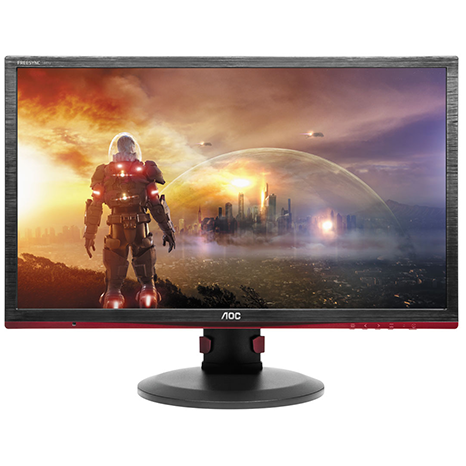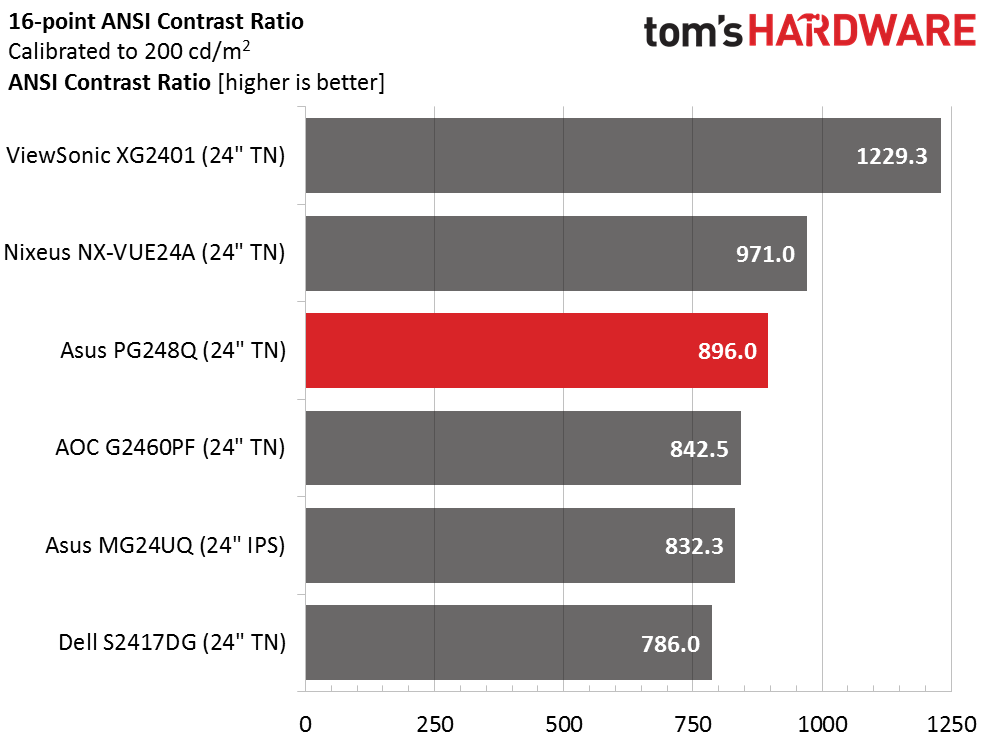Asus ROG PG248Q 24-inch 180Hz G-Sync Gaming Monitor Review
Asus practically founded the gaming monitor category with the VG248QE in 2013. Today we’re looking at its spiritual successor, the ROG Swift PG248Q. It’s a 24" TN screen with FHD resolution, G-Sync, ULMB, and a 180Hz refresh rate.
Why you can trust Tom's Hardware
Brightness & Contrast
To read about our monitor tests in depth, please check out Display Testing Explained: How We Test Monitors and TVs. Brightness and Contrast testing is covered on page two.
Uncalibrated – Maximum Backlight Level
Today’s group consists solely of 24" gaming screens. They are all TN except for the MG24UQ, which is an Ultra HD IPS panel with Freesync. The closest match to our review subject is Dell’s S2417DG, which offers G-Sync and QHD resolution. Remaining screens sport FreeSync and FHD. They are ViewSonic’s XG2401, AOC’s G2460PF, and Nixeus’ NX-VUE24A.
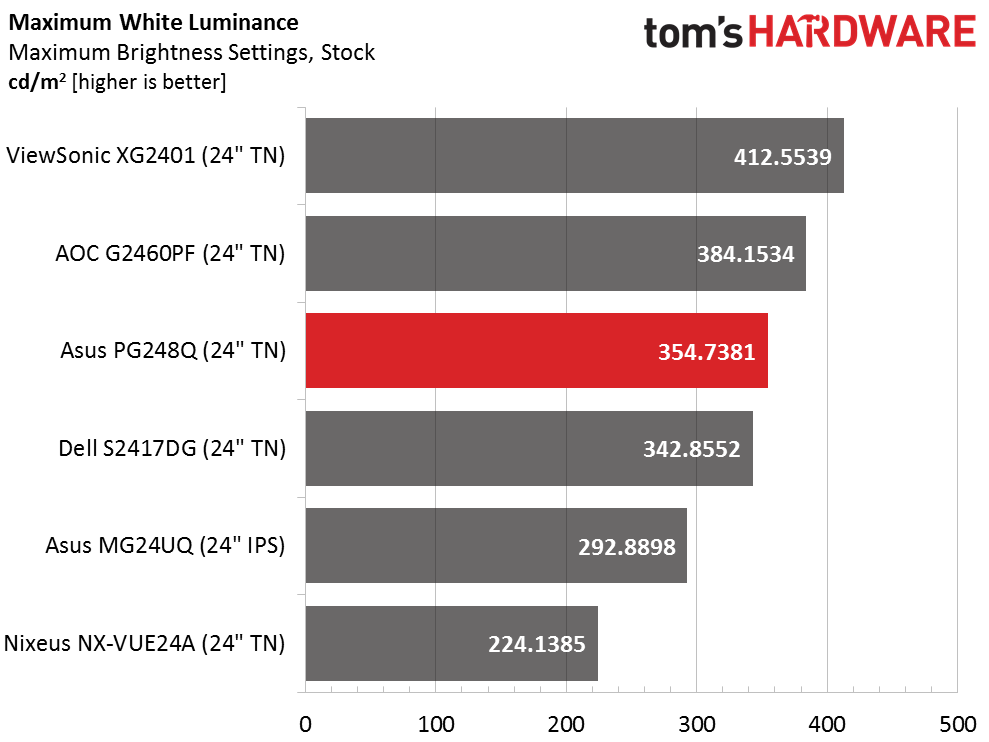

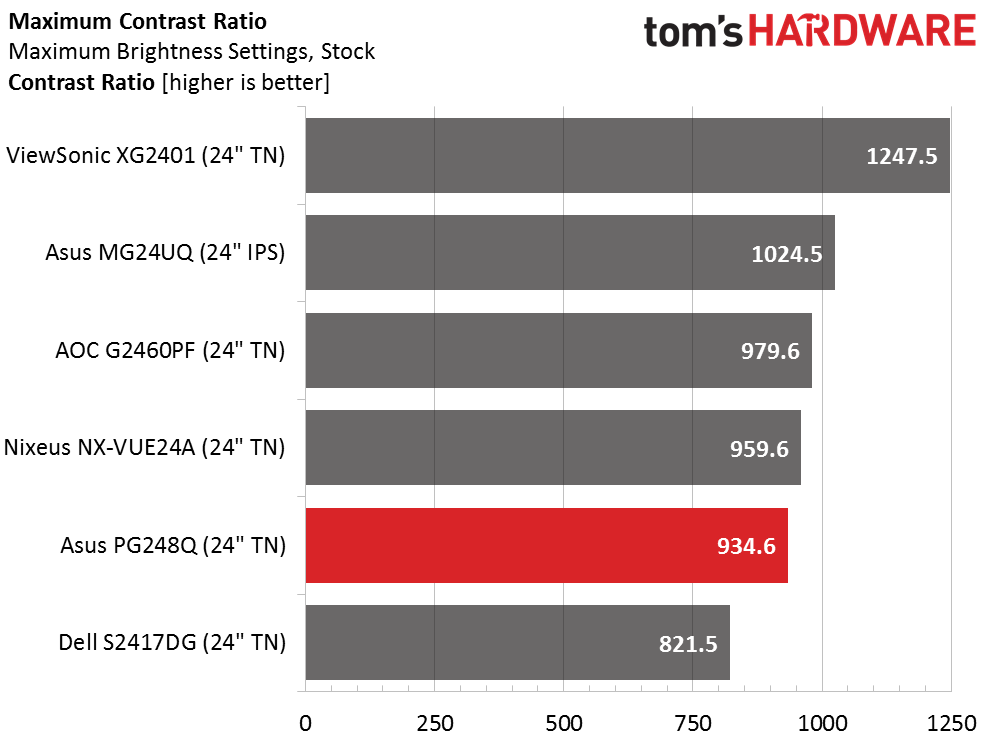
Any monitor offering ULMB needs high output. The backlight strobe reduces light by quite a bit. In the PG248Q’s case it’s a 50% reduction at the maximum pulse width setting. Lowering the slider will make the picture even darker. If you decide to use this option, we recommend maxing the brightness slider.
Black level results fall in the middle of the pack, but because other screens have greater output, the resulting contrast ratio falls below 1000:1. The overall spread from bottom to top is relatively small, although the ViewSonic excels in this class at over 1200:1. A premium screen like the PG248Q should have just a little more punch.
Uncalibrated – Minimum Backlight Level
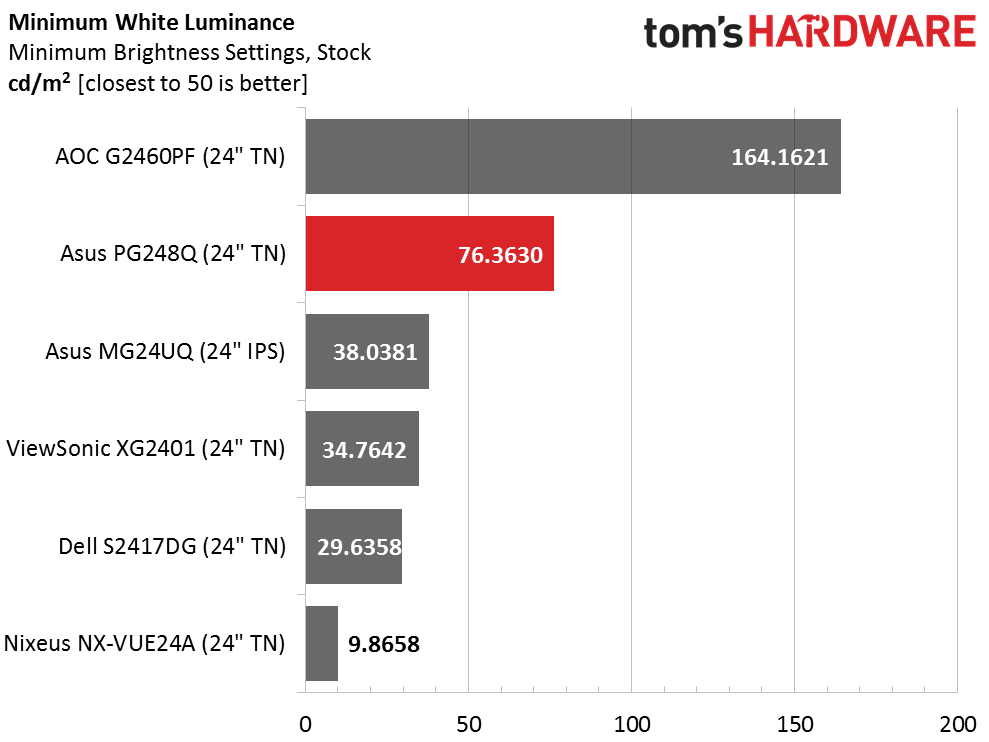
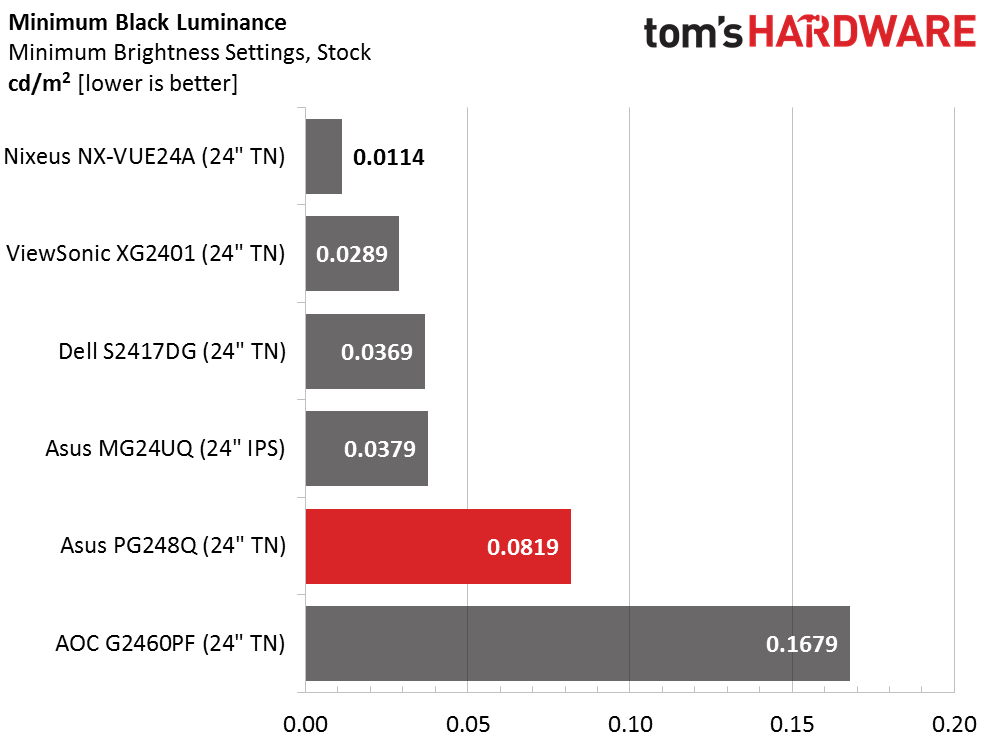
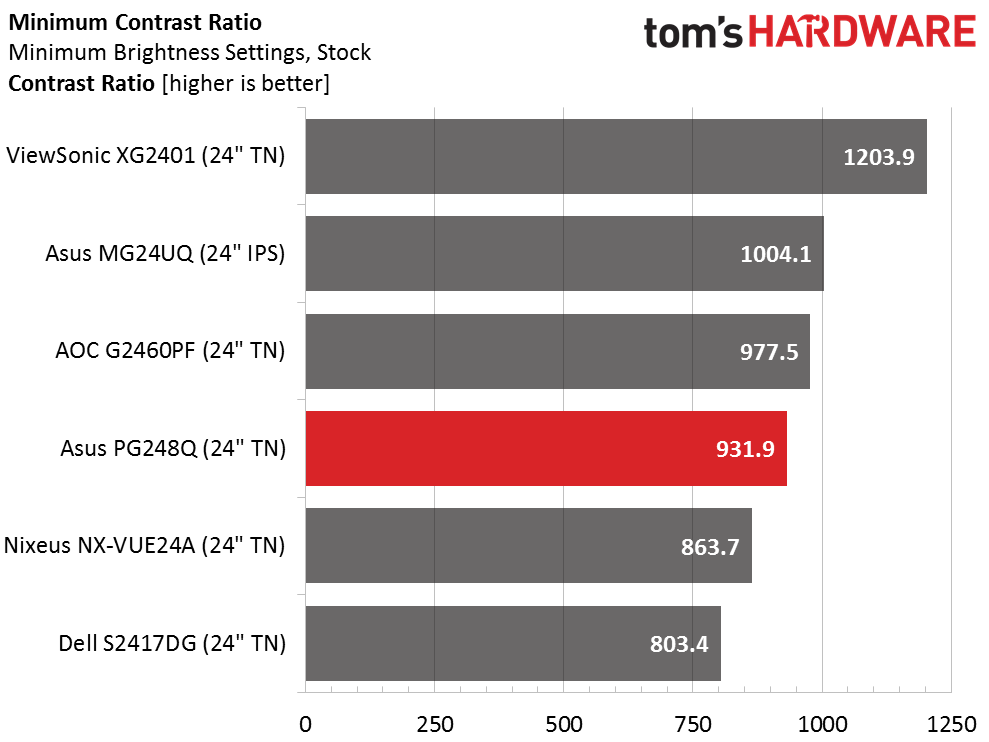
The PG248Q won’t quite dip down to 50cd/m2 but its minimum level of 76.3630cd/m2 is very usable in a dark room environment. The contrast ratio remains consistent at all backlight settings rendering an identical perception of depth regardless of output.
After Calibration to 200cd/m2

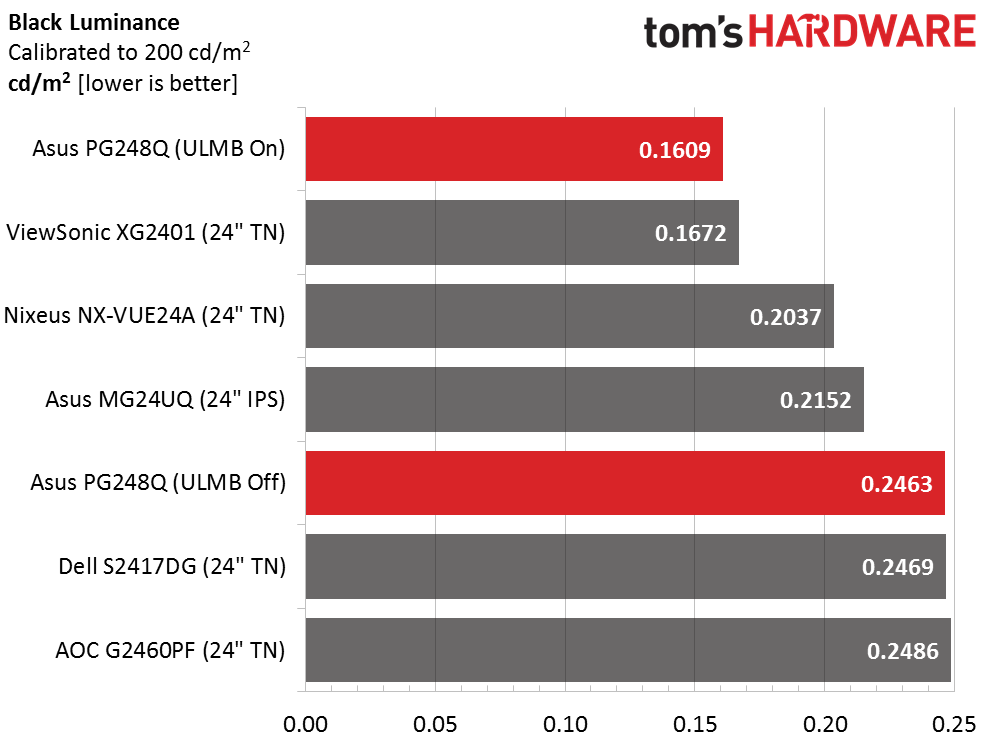
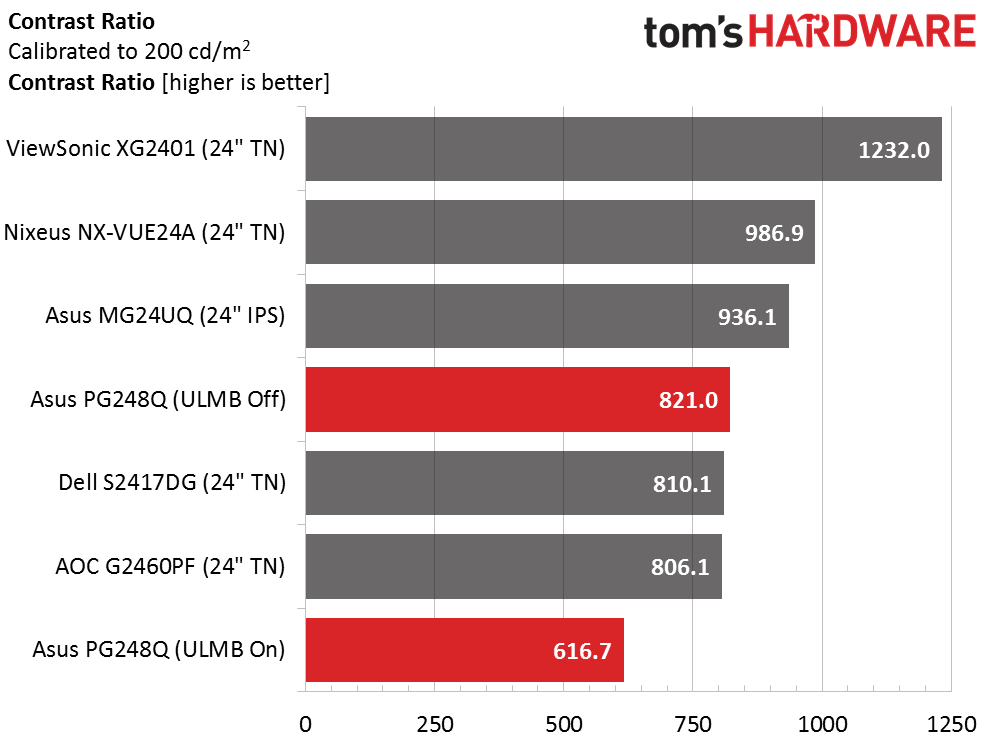
Since we had to lower the contrast control to solve clipping and gamma issues, overall dynamic range suffers slightly. We’re also showing you the effects of ULMB. In this case it’s set to the highest possible pulse width, which is as bright as it can be. Our result of 99.0736cd/m2 is relative to a 202.2137cd/m2 level and does not represent the full output available with ULMB. That will depend on the brightness setting. We recommend maxing it for best picture quality when using the blur reduction feature. Better yet, stick with G-Sync at 180Hz and you’ll get more light and more contrast with no motion blur or tearing.
ANSI Contrast Ratio
The ANSI contrast result is a good bit higher than the sequential one, which indicates a well-engineered panel that uses quality parts, especially the grid polarizer. Intra-image contrast is therefore strong and manages to compete favorably with the other monitors except the ViewSonic, which is in a class by itself when it comes to contrast. While our contrast results are not stellar, overall picture quality is decent, especially when you consider motion processing, which, as you’ll read about later, is without peer.
Get Tom's Hardware's best news and in-depth reviews, straight to your inbox.
Current page: Brightness & Contrast
Prev Page OSD Setup & Calibration Next Page Grayscale, Gamma & Color
Christian Eberle is a Contributing Editor for Tom's Hardware US. He's a veteran reviewer of A/V equipment, specializing in monitors. Christian began his obsession with tech when he built his first PC in 1991, a 286 running DOS 3.0 at a blazing 12MHz. In 2006, he undertook training from the Imaging Science Foundation in video calibration and testing and thus started a passion for precise imaging that persists to this day. He is also a professional musician with a degree from the New England Conservatory as a classical bassoonist which he used to good effect as a performer with the West Point Army Band from 1987 to 2013. He enjoys watching movies and listening to high-end audio in his custom-built home theater and can be seen riding trails near his home on a race-ready ICE VTX recumbent trike. Christian enjoys the endless summer in Florida where he lives with his wife and Chihuahua and plays with orchestras around the state.
-
shrapnel_indie Uh, another con that is NOT listed: lack of FreeSync. Why? G-Sync already excludes AMD cards (and while it is considerably less important to most of us, Intel iGPUs too.) With FreeSync not having the NVidia G-Sync "tax"... oh wait... NVidia might contractually exclude the possibility of any monitor that include FreeSync and/or older adaptive-sync technologies in addition to G-Sync.Reply -
JackNaylorPE 1. Both Asus and Acer have always offered both G-Sync and Freesync versions of their Gaming monitors. The only impact on the consumer is the effort choosing the one that matches their card. No real mystery that the nVidia version hits the market 1st given the image below. Not really a mystery when vendors concentrate on the 82% of market before addressing the 18% of market.Reply
2. Either way, 144, 165, 180 Hz provides technology that represents the upper cost niches as opposed tot he lower. Peeps purchasing monitors at the upper price limits in any given category are likely to be purchasing GFX cards in the upper price limits. So what we see when pepes post their builds for the most part is GTX 1060s / RX 470s paired with $250 monitors. With 1070 / 1080s in the build, the monitor budget is a bit higher.
3. It may be fun to call the price difference a "tax" but that is a misnomer:
AMD Freesync package provides Freesysnc and no hardware module is installed in the monitor.
nVidia G-Sync provides G-Syn and also includes a hardware module for ULMB
When two monitors are made using the same panel, and electronics ... then one has a hardware module installed which provides ULMB and the other does not, is it not logical that that hardware module has a cost associated with it ? You can buy Freesync monitors with motion blur technology included but in such cases it is added by the monitor manufacturer. The difference being that w/ G-Sync, it's always the same module... with Freesync, the design and quality varies by monitor manufacturer.
Never quite understood the mindset where there's an expectation that a company should invest millions of dollars in R&D and then should be required to share that technology for free. AMD has had the opportunity to license technology in the past and chose not to.
4. As it says in this review:
"While FreeSync offers the same net benefit, it takes a bit more digging to find the panels that can hit a 30Hz lower limit. Many stop the fun at 40Hz, which can be an issue for users of less expensive video cards."
The digging will usually result in a monitor from a manufacturer who chose a more expensive panel which of course. like adding the MBR module, adds to the cost.
I am not making a judgement as to whether the cost increase is "worth it".... that judgment will vary according to each individual. But the claim that the two technologies are "the same" or provide the same features and performance is just incorrect. -
JackNaylorPE Regarding the article....Reply
1. Regarding the "out-of-box" accuracy, I expect that you will be able to download corrected ICC profiles for this monitor shortly on TFTcentral
2. When Acer made the move to 165 Hz in their Predator line, the 165 Hz was considered of no significant impact and many called it a gimmick. 165 Hz tho made one very important impact.... it allows a 120 Hz setting under ULMB, up from the 100 Hz that was available w/ the 144 Hz model. It would appear that 180 Hz offers no advantage here.
3. I keep wondering why we don't see IPS panels in this segment ... guess is that by the time one includes a gaming capable IPS panel and modern hi-end gaming technology to support it, the price is so close to a 1440p panel, most would just choose the larger panel. -
rwinches So The AOC 144Hz Freesync 35 - 144Hz. is the better buy and at ~$210 you can get two.Reply
As you said, once you use TH recommended settings and start gaming The AOC is a great choice. Tom’s Hardware Editor Approved Award
Tom's Conclusion Page
http://www.tomshardware.com/reviews/aoc-g2460pf-24-inch-144hz-freesync-monitor,4743-6.html -
JackNaylorPE I generally don't use THG reviews for decision purposes as the articles are the kind that "listen to Mom"" and follow the old adage "if ya don't have something nice to say, then don't say anything at all". As far as AOC, in my eyes, well let's just say I'm not a fan.... at least not till I see one I'm impressed with and that hasn't happened so far.Reply
As far as response time goes.... wish we had more detail and with lag added in for all reviews so that a valid comparison can be made.
Would like to see something like this
User reviews on newegg aren't too reassuring for the G2460PF with just 12 peeps contributing:
5 eggs = 33%
4 eggs = 42%
3 eggs = 0%
2 eggs = 8%
1 egg = 17%
and the ones complaining are citing no support and failure to meet spec.
http://www.newegg.com/Product/Product.aspx?Item=9SIA8X548C3991
Compare that to the 1,171 Asus VG248QE reviews
5 eggs = 72%
4 eggs = 13%
3 eggs = 5%
2 eggs = 4%
1 egg = 5%
Again, for me I wouldn't touch that AOC ... I would touch this Asus either. Before I'd spend $500 on a TN 1080p panel, I'd save up another $200 and get a 1440p IPS, 165 Hz Acer Predator or Asus Swift. Peeps tend to keep monitors thru 2 or 3 builds so there's a tendency here to invest a bit and get something better since it will be around a lot longer.
With today's video cards (i.e. 1070) ... I think if pushed into a corner @ 1080p until I could afford a 1440p, I'd be more likely to choose a VG248QE w/ no G-Sync. With every game above 60 fps ... G-Sync or Freesync really won't be missed since a) it's value is really below that threshold and b) you can do motion blur reduction via the toasty strobelight utility. Could then use the Vg248QE as an accessory monitor for monitoring utilities, ventrillo, etc
http://www.tftcentral.co.uk/articles/variable_refresh.htm
It should be noted that the real benefits of G-sync really come into play when viewing lower frame rate content, around 45 - 60fps typically delivers the best results compared with Vsync on/off. At consistently higher frame rates as you get nearer to 144 fps the benefits of G-sync are not as great, but still apparent. There will be a gradual transition period for each user where the benefits of using G-sync decrease, and it may instead be better to use the ULMB feature included, which is not available when using G-sync. Higher end gaming machines might be able to push out higher frame rates more consistently and so you might find less benefit in using G-sync. The ULMB could then help in another very important area, helping to reduce the perceived motion blur caused by LCD displays. It's nice to have both G-sync and ULMB available to choose from certainly on these G-sync enabled displays.
-
zodiacfml Way above my padded price expectation of $400.Reply
THG, can you do a blind test comparing 120 Hz monitor versus this?This is to find if there's any value to ever increasing refresh rates. -
Verrin Not sure why people still make a big deal out of the lower refresh limit on FreeSync monitors. AMD has been compensating for that in software (called LFC), much like Nvidia does, for more than a year now. I've not seen screen tearing below 35Hz since FreeSync monitors first came out.Reply -
DornyeiJ The refresh rate has no impact after a certain limit as the human mind has its own refresh rate what is limited. I think that something like 120 Hz is already higher as needed. This is the reason games are not pushing higher refresh rate. Games instead add more detail and image quality. I think this monitor is overkill. However ASUS will be able to sell it as some people with a lot of money will buy it. I will stick to a cheaper monitor with about 120 refresh rate.Reply
